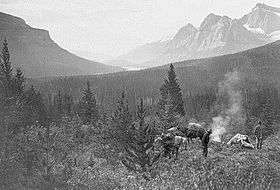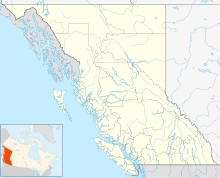Howse Pass facts for kids
Quick facts for kids Howse Pass |
|
|---|---|

A camp in the Howse Pass in 1902
|
|
| Elevation | 1,539 m (5,049 ft) |
| Location | Alberta–British Columbia border, Canada |
| Range | Canadian Rockies |
| Coordinates | 51°48′N 116°45′W / 51.800°N 116.750°W |
| Official name | Howse Pass National Historic Site of Canada |
| Designated | 1978 |
Howse Pass is a special pathway through the Rocky Mountains in Canada. It sits high up at about 1,539 meters (5,049 feet) above sea level. This pass is a natural gap between tall mountains, making it easier to travel from one side of the Rockies to the other.
Contents
Exploring Howse Pass
Howse Pass is found within Banff National Park, a famous park known for its amazing scenery. It lies between two mountains called Mount Conway and Howse Peak.
Where the Waters Flow
One cool thing about Howse Pass is how water flows from it. On the east side, water from Conway Creek flows into the Howse River. This river then joins the North Saskatchewan River, which eventually reaches Lake Winnipeg and then Hudson Bay. So, water from here travels all the way to the Atlantic Ocean!
On the west side, water drains into the Blaeberry River. This river flows into the mighty Columbia River, which then carries the water all the way to the Pacific Ocean. This means Howse Pass is a "continental divide" – a place where water flows to different oceans.
A Path Through History
Long ago, First Nations people used Howse Pass to travel and trade. Groups like the Kootenay from the west and the Peigan from the east used this route.
In 1806, two men from a trading post called Rocky Mountain House started to clear a rough path towards the pass. Then, in June 1807, a famous explorer named David Thompson became the first known European to cross Howse Pass. He used it to reach the Columbia River.
The pass was later named after Joseph Howse. He was a leader with the Hudson's Bay Company, a big fur trading company. Joseph Howse crossed the pass in 1809. Even though it was used, another pass called Athabasca Pass became more popular for travel.
Why No Railway?
Howse Pass is lower than many other mountain passes in the Rockies. Because of this, it was considered as a possible route for the Canadian Pacific Railway. This railway was a huge project to connect Canada from east to west.
However, another pass called Kicking Horse Pass was chosen instead. This was because Kicking Horse Pass offered a better route for the railway. There has been some talk about building a road through Howse Pass in the future, connecting Saskatchewan River Crossing to Golden, British Columbia. But this would mean building through a national park, which is a big decision.
A Special Place
Because of its important history and natural beauty, Howse Pass was named a National Historic Site of Canada in 1978. This means it's a place recognized for its special meaning to Canada's past.



